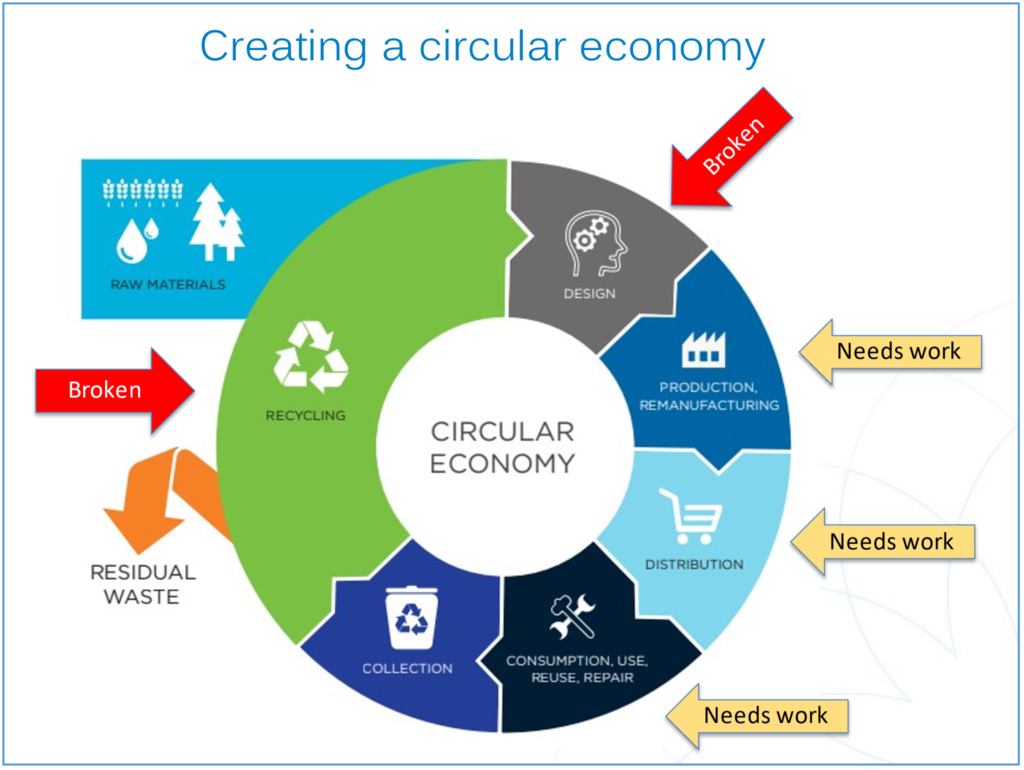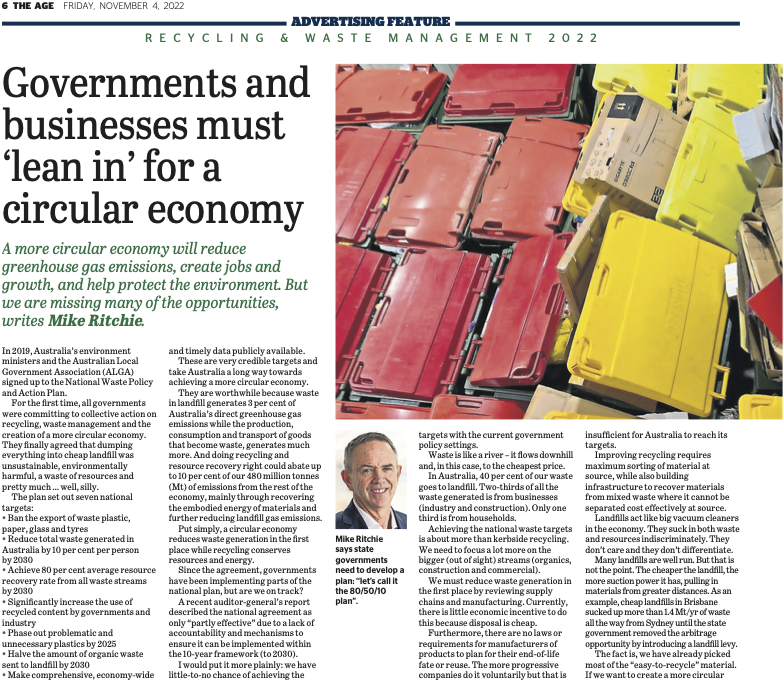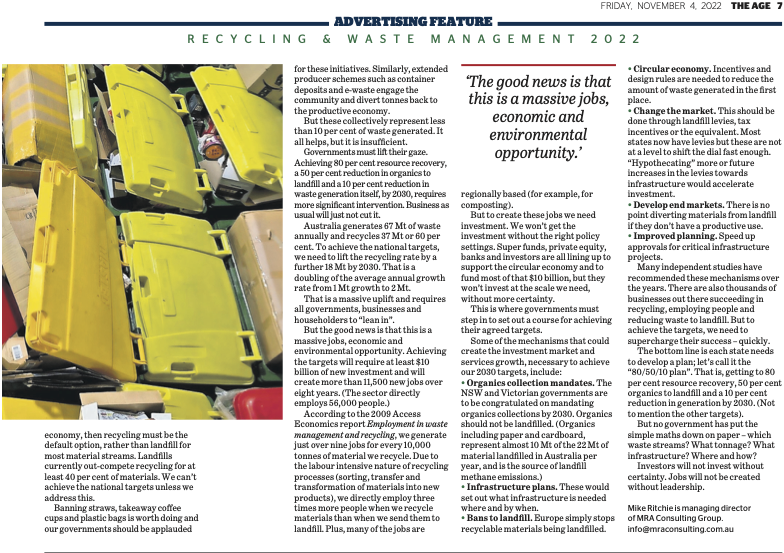Achieving our waste targets
By: Mike Ritchie, MRA Consulting Group

In 2019, Australia’s environment ministers and the Australian Local Government Association (ALGA) agreed to the National Waste Policy and Action Plan (NWPAP).
For the first time, all Governments were committing to collective action on recycling, waste management and the creation of a more Circular Economy. Our governments finally agreed that dumping everything into cheap landfill was unsustainable, environmentally harmful, a waste of resources and pretty much silly.
The Plan set out seven national targets:
- Ban the export of waste plastic, paper, glass and tyres;
- Reduce total waste generated in Australia by 10% per person by 2030;
- Achieve 80% average resource recovery rate from all waste streams by 2030;
- Significantly increase the use of recycled content by governments and industry;
- Phase out problematic and unnecessary plastics by 2025;
- Halve the amount of organic waste sent to landfill by 2030; and
- Make comprehensive, economy-wide and timely data publicly available.
These are very credible targets and take Australia a long way towards achieving a more Circular Economy.
We should be supporting these targets because:
- Waste generates 3% of Australia’s direct greenhouse gas emissions;
- Doing recycling and resource recovery right could abate up to 10% of our 480MT of emissions from the rest of the economy mainly through recovering the embodied energy of materials and reducing landfill gas;
- Recycling and a circular economy saves resources and energy; and
- Recycling reduces litter and illegal dumping.
Governments have been implementing parts of the NWPAP over the intervening 3 years. But are we on track? We are currently recycling 60% of Australia’s 61MT of generated waste (2020 National Waste Report using 18/19 data). The target is 80%.
A recent Auditor General’s report (September 2022) said that the Plan is only “partly effective” due to a lack of accountability and mechanisms to ensure that it can be implemented within the 10-year framework (now only 8 years to 2030).
I would put it more simply:
We have little to no chance, of achieving the Targets with the current policy settings.
Tweet
Why do I say that? Well, there are a few principles about waste to discuss first:
- Two thirds of all waste generated is from businesses (industry and construction). Only one third is from households. Of the household waste generated only 20% is in the Yellow Bins. Achieving the national waste targets is about more than kerbside recycling. Business generates almost 80% of all waste.
- We must reduce waste generation in the first place by reviewing supply chains and manufacturing. There is little economic incentive to do this at present because disposal is still cheap. There are no laws or requirements for manufacturers of products to plan for the end of life fate or reuse of their products.
- Improving recycling requires maximum sorting of material at source whilst also building infrastructure to sort mixed waste where it cannot be separated at source.
- Waste is like a river, it flows downhill. In this case, to the cheapest price. In Australia that is almost always cheap landfill.
- Landfills act like big vacuum cleaners in the economy. They suck in both waste and resources indiscriminately. They don’t care and they don’t differentiate.
- The cheaper the landfill, the more suction power it has, pulling in materials from greater distances. As an example, cheap landfills in Brisbane sucked over 1.4 MT/yr of waste all the way from Sydney.
- We currently recycle just over 60% of the 61 MT/yr of waste generated (or 37MT recycled). But we have already picked most of the “easy to recycle” material.
- If we want to create a more circular economy then recycling must be the default option, not landfill.
We can’t achieve the national targets unless we address the above.
Banning straws, takeaway coffee cups and plastic bags are worth doing, but they represent 0.01% of waste to landfill. Governments must lift their gaze.
Tweet
Achieving 80% resource recovery and a 50% reduction in organics to landfill, by 2030 requires more significant intervention. Business as Usual just wont cut it.
By 2030, the projected national waste generation rate is 70 MT/yr. Hence the goal to recover 80% of that equals 56 MT/yr. This requires growth in resource recovery of at least 18 MT/yr over the 8 years remaining to 2030. That is at least 2 MT of additional growth per year.
Australia has been fairly successful in driving recycling upwards, by a little over 1 MT/yr. That includes new collection services, businesses separating their recyclable plastic, metals and cardboard, households separating their food and garden waste etc as well as building new waste sorting and processing infrastructure including composting and reprocessing factories. The sector now employs 56,000 people as a result of this growth.
But to achieve the targets we need to double the historic rate of growth of recycling collection and processing (to 2 MT/yr). That is a massive uplift and requires all governments, businesses and householders to “lean in”.
It is worth pointing out this is also a massive economic and jobs opportunity. Achieving the targets will require at least $10B of new investment and will create more than 11,500 new jobs over 8 years. According to the 2009 Access Economics report Employment in waste management and recycling, we generate just over 9 jobs for every 10,000 tonnes of material we recycle. Due to the labour intensive nature of recycling processes (sorting, transfer and transformation of materials into new products), we also employ 3 times more people when we recycle materials than when we landfill them. Plus, many of the jobs are regionally based (e.g. composting).
But to create these jobs we need investment. We won’t get the investment without the right policy settings. Super funds, private equity and investors are all lining up to support the Circular Economy but they won’t invest at the scale we need without certainty.
Here are the key mechanisms that could create the investment market and services growth, necessary to achieve our 2030 targets:
- Organics collection mandates. The NSW Government is to be congratulated on mandating commercial organics collections by 2025 and household organics by 2030. Organics should not be landfilled. (Organics represent about 7 MT of the 22 MT of waste landfilled in Australia and most of the source of landfill greenhouse emissions).
- Infrastructure for sorting mixed waste into reusable streams and for reprocessing. The private sector will fund it if they have the right price signals to invest.
- Bans to landfill. Europe simply stops things being landfilled. Ban the landfilling of organics, timber, e-waste etc.
- Change the market by making landfills relatively more expensive than recycling. Most states now have landfill levies but these are not at a level to shift the dial fast enough. “Hypothecating” future increases in the levies towards infrastructure would accelerate investment.
- Develop end markets to bring about a pull-through effect. There is no point in diverting materials from landfill if they don’t have a productive use.
- Improved Planning for resource recovery infrastructure to speed up the approvals process before 2030.

Many independent studies have recommended these initiatives over the years. What is missing is the political will to introduce and drive them.
The bottom line is each State Government needs to develop a Plan on “How to get to the 80% resource recovery and 50% organics targets” (not to mention the other 5 targets). Not a single Government has put the maths down on paper – What waste streams, What tonnages, What infrastructure, Where and by When? Investors will not invest without certainty. Jobs will not be created without leadership.
The buck stops with the Meeting of Environment Ministers (from both Federal and State Governments) along with local government. It is a win, win, win for jobs, the economy and the environment. We just need the right leadership.
Tweet
Mike Ritchie is the Managing Director at MRA Consulting Group.
This article has been published by The Age and SMH in a November 4, 2022 feature:





